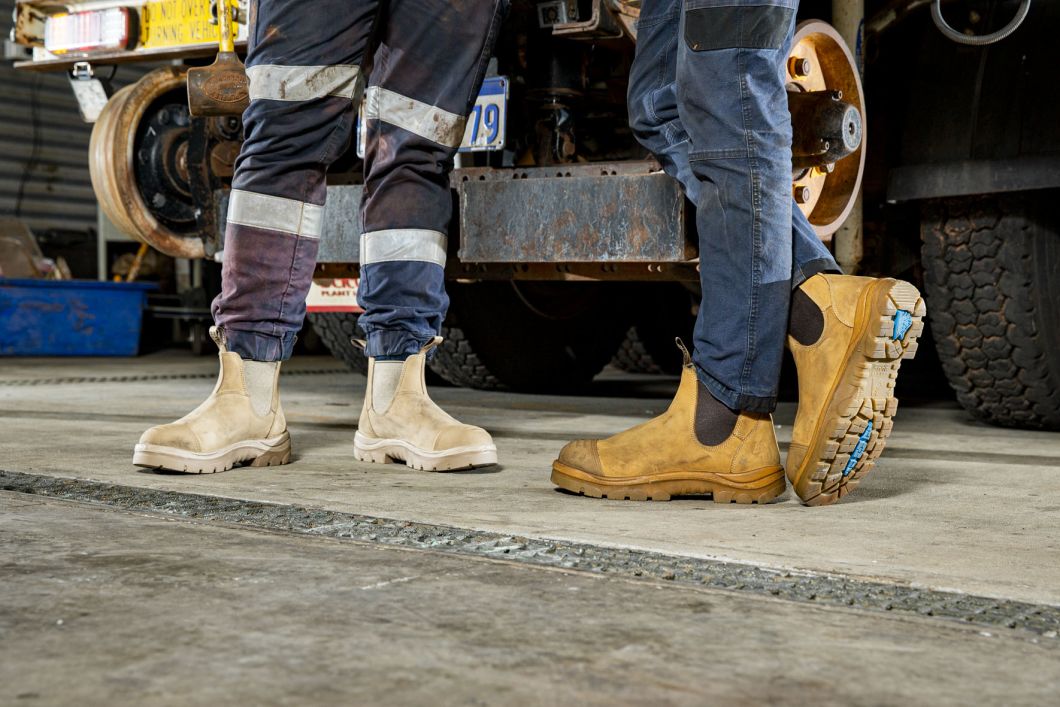 Have you ever thought about what safety standards your work boots meet or what each safety standard means?
Have you ever thought about what safety standards your work boots meet or what each safety standard means?
Know your limits to stay safe on site
We throw around the term “steel caps” fairly freely these days. In conversation, it refers to virtually all types of safety boots worn on job sites.
From oil rigs to remote mine sites, foundries to factories, dock work to digging a ditch, steel cap work boots are standard.
But there’s more to work safety boot standards than you might think.
Let’s dive into the difference between international safety standards and what it means for your protection on the job.
The steel cap safety standards you need to know
For work boots to pass muster, they must meet strict standards.
What exactly those standards involve – the tests and trials that your boots need to endure – changes slightly depending on where you work.
Australian and New Zealand safety standards for work boots
Steel cap boots in Australia need to comply with two safety standards:
- AS/NZS 2210.3 (ISO 20345:2011, MOD)
Toe protection is the minimum standard to meet this standard. Steel or composite toe protection must pass impact and compression tests to ensure your feet are safe from a drop force of 200 joules.
- AS/NZS 2210.5 (ISO 20347:2012, MOD)
Commonly called the “Occasional Footwear Standard”, 2210.5 puts a safety boot through its paces, testing for:
- Non-slip sole performance
- Ergonomics
- Upper, midsole and lining material quality
- Outsole material testing
ASTM F2413-18
After reviews in 2005 and 2009, OSHA’s PPE requirements for manual workers have been revised for the 21st century.
Safety boot performance was included in that review. After all, steel cap boot technology has come a long way since 2005.
ASTM F2412-18a covers the standard tests for foot protection, including impact and compression resistance. But the standard to focus on is ASTM F 2413-18.
ASTM F 2413-18 covers work boots manufactured with an integrated composite or steel toe cap. As well as impact and compression, the required tests can include:
- Conductive protection
- Electrical Hazard (EH) protection
- Metatarsal protection
- Electrical properties
- Puncture resistance
EN ISO 20345
European and international PPE safety standards were synchronised in the late ’80s. Today, most of the world’s safety boots are tested against EN ISO 20345. Specifically, the 2011 revision, which was updated to include updated text and adapted tests for today’s trades.
Similar to AS/NZS and ASTM standards, EN ISO 20345 sets performance benchmarks for safety boots in a range of criteria, including:
- Drop force
- Slip resistance
- Ankle support
- Heat resistance
- Water resistance
- Insole abrasion resistance
Specialist footwear standards, like EN ISO 20349-1 foundry footwear and EN ISO 17249, forestry footwear, are based on 20345 with supplementary text based on specific risks.
Metatarsal Protection
Steel Blue’s Met-Guard, or Metatarsal Guard, is specially designed to protect the metatarsal area of the foot that extends from the toes - roughly the 'middle' of your foot, between the toes and your ankle.
Met-Guard is a popular choice for mining workers, factory hands and drillers, who sometimes need the extra protection the Met-Guard affords.
Electrical Protection
Most Steel Blue boots are Anti-Static, meaning they dissipate the amount of static electricity build-up on your body. In fact, they actually conduct the static electricity through the soles and into the ground.
This offers a level of protection against ignition hazards such as flammable materials and gases.
If you work with flammable materials, ignitable gases, sensitive electronic equipment or in an environment that creates static electricity build-up (where you get ‘zapped’ from touching doors and machinery), you’ll benefit from these Steel Blue boots.
The Anti-Static range of Steel Blue safety boots complies with:
- Australian and New Zealand Safety Footwear Standard AS/NZS 2210.3
- International and European Safety Footwear Certification EN ISO 20345
- American Safety Footwear Certification ASTM F2413
Steel Blue’s Non-Safety Anti-Static work boots also comply with Australian and New Zealand Safety Footwear Standard AS/NZS 2210.5, International and European Safety Footwear Certification EN ISO 20347, and American Safety Footwear Certification ASTM F2892
Anti-Static work boots should be cleaned and tested regularly to ensure the Anti-Static properties haven’t deteriorated. Flexing, contamination and moisture can change their electrical resistance.
Puncture Resistance
For added safety and piece of mind, a super tough steel component is available in some styles, to help reduce the risk of sharp objects puncturing your work boots.
Highly regarded in construction and industrial workplaces, Penetration/Puncture Resistant safety boots are a popular choice for carpenters, fabricators, demolition workers and those working in glass production and installation. This can be essential to limit the risks of embedding a long rusty nail halfway through your foot.
How to choose safety boots that will support you every day
It’s not a stretch to say labels save lives when it comes to PPE.
Steel cap work boots are required to carry a label indicating which standards they comply with and which safety features are built in.
Check these labels carefully. Some manufacturers might make confusing claims, such as promoting their work boots as “non-slip” and “water repellent”.
You can find the common label markings to look out for here (click to open in new tab)





